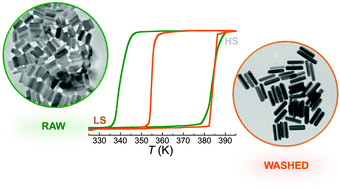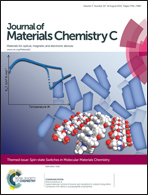Critical assessment of the nature and properties of Fe(ii) triazole-based spin-crossover nanoparticles†
Abstract
The shape and size of nanoparticles of the spin crossover compound [Fe(Htrz)2trz]BF4 obtained by the reverse-micelle method and using as co-surfactants dioctylsulfosuccinate and behenic acid are described through systematic transmission electron microscopy observations. A rod shape is systematically derived, and the rod sizes, in particular, their width, are controllable through the surfactant concentration, although a poor reproducibility is observed and ascribed to uncontrolled parameters in the micelle elaboration and microemulsion formation and ageing. The influence of synthetic parameters and nanoparticle processing on the spin crossover properties of nanoparticles is also reported, as characterized by both calorimetry and magnetic measurements. These unravel original size and environment effects. On the one hand, the hysteresis width of the thermal spin crossover exhibited by raw nanoparticles increases linearly with the rod width, until it reaches a value of 40 K, close to that of the bulk material. A similarly good correlation is found with the nanoparticle volume. On the other hand, the removal of the surfactant from the raw nanoparticles is found to systematically reduce the hysteresis width in a drastic manner, by up to 16 K.

- This article is part of the themed collection: Spin State Switches in Molecular Materials Chemistry

 Please wait while we load your content...
Please wait while we load your content...